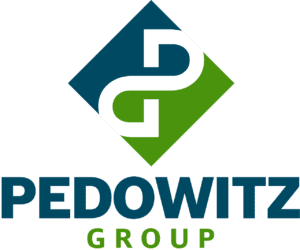Marketing is dead in the water without strong lead management.
The modern marketing leader is laser-focused on revenue impact. To achieve that goal, you need to identify the quickest, most direct path to get there.
Think about it: Marketing generates qualified leads OR creates well-educated buyers within identified targets through demand generation or account-based marketing activities. Then, key contacts in a company’s buying center are identified and surrounded by sales and marketing in a joint effort, leading to productive conversations that drive sales.
As a part of this process, you must know at any given moment what’s in your marketing pipeline, what will convert to sales, and the estimated revenue.
You should also know which lead sources to impact the pipeline best. That could be in terms of the most valuable leads (the ones with the highest value and probability to close), the places your ideal customer spend their time, and more.
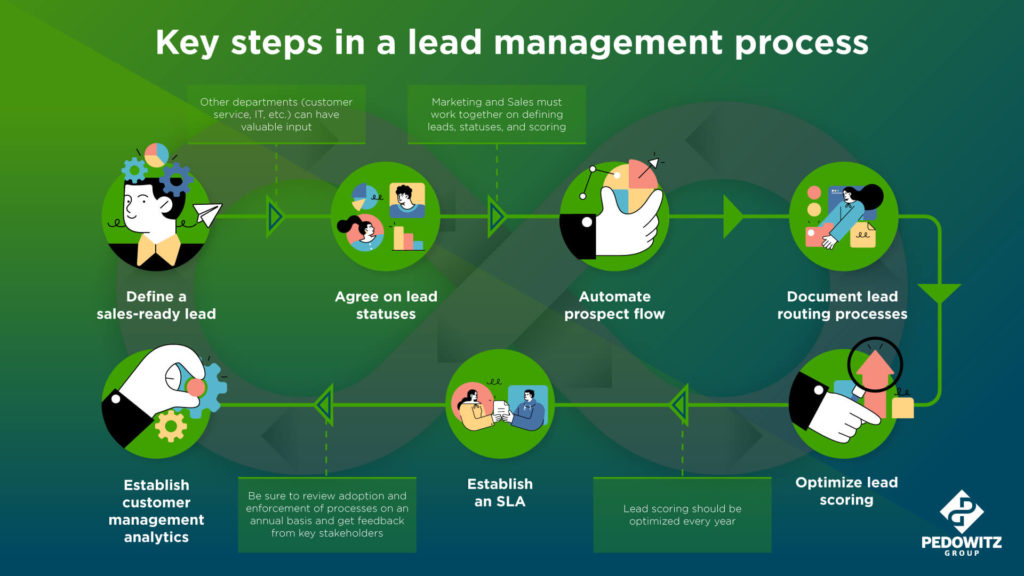
But how can you ensure any identified targets receive the best customer experience possible?
An effective lead management process. (We help with full pipeline optimization, by the way)
Having a good framework allows you to:
- Increase revenue
- Decrease cost of sales; close/win more opportunities
- Retain more customers
- Invest ONLY in activities that generate real value for the business
- Have COMPLETE alignment between sales and marketing
- Know lead conversion metrics by level from end to end
- Follow up with an interested prospect quickly
- Enhance the customers’ experience when they are engaging with your organization
Want to evolve your lead management? Grab a free copy of F The Funnel (opens in a new tab) for a new way of thinking – we’ll touch on this towards the end of this article, too.
So, ready to dive in? Click to jump to a stage:
The Business Case | Define SQLs | Define Stages | Automate | Document Flow | Optimize Scoring | Establish SLAs | Map Past The Sale
The business case for why lead management is so important
First, let’s level set on what lead management is, to ensure we’re talking about the same process:
Lead management is a methodology whereby marketing generates qualified leads, passes them seamlessly and efficiently to sales, and sales/marketing processes them through to close. It combines people, processes, and technology, a shared capability for marketing and sales.
Your lead management process paves the way for Sales and Marketing to create an efficient and effective revenue machine. Organizations with mature lead management processes gain the following benefits:
- Increased revenue via average deal size or month/annual recurring revenue
- Expedite the sales qualification process
- Expedite average opportunity to close
- Follow up with buying-interest level prospects quickly
- Have a central view of the customer across all customer-facing functions
- Make it easier for buy-ready leads to engage with your sellers
A strong lead management process will get you these results, and much more. Marketo found that “aligned organizations had 67% higher conversion rates and their leads generated over 209% more revenue.”
We’ve seen aligned processes lead to tens of millions in realized revenue firsthand.
Marketing and sales won’t thrive without the other – and it takes an effective process to help it happen!
Two very important caveats to know before reading:
#1 – There are seven key stages to master, each building upon the other. A single, poorly-managed stage creates a domino effect on the other stages, causing them to suffer and leaving revenue on the table.
If you read through this and identify an early step that really could use work, that’s your starting point. Any other later stage will be less effective until you tackle the earlier stages.
#2 -This is doomed to fail if you don’t have executive buy-in. You need proper top-down accountability and investment throughout each stage, especially as you continue to evolve and transform your organization.
Marketing can’t simply have a CRM report showing Sales follow-up rates. All this does is drive a wedge between the two teams. If the C-level isn’t driving needed change, showing the requisite patience, and holding both teams accountable, the company suffers.
Stage 1: Reach agreement on the definition of a qualified or sales-ready lead
Initially, marketing and sales must agree on what makes a sales-qualified lead (SQL). Having these definitions ensures only high-quality leads are passed to sales.
A SQL is someone who demonstrates a pre-determined “fit” and buying readiness based on measurable demographic and behavioral attributes that sales and marketing agree on:
- Demographic attributes include the contact name, phone number, and email address.
- Behavioral attributes include a demonstrated interest or need, web page visits, high-value form fills, inbound engagement, and so on.
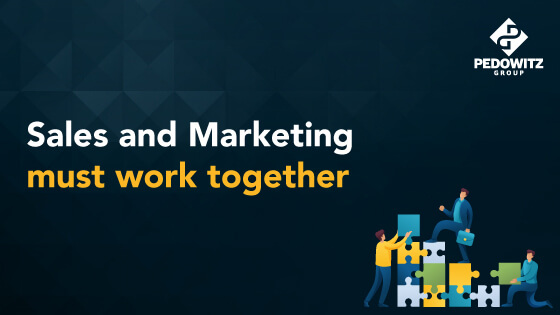
All too often, however, Marketing works with one definition while Sales has an entirely different baseline.
Both need to agree on what a sales-ready lead is so that Marketing will pass only usable leads to Sales, which helps Sales as they don’t have to filter through junk to get to what they should be acting on.
Related: Know your numbers. Invest wisely in your marketing operations
Alignment results in value. To earn value, you must work hard together in the same room and hash out what is and is not a sales-ready lead, defined by demographic and behavioral attributes.
Some examples may include the following:
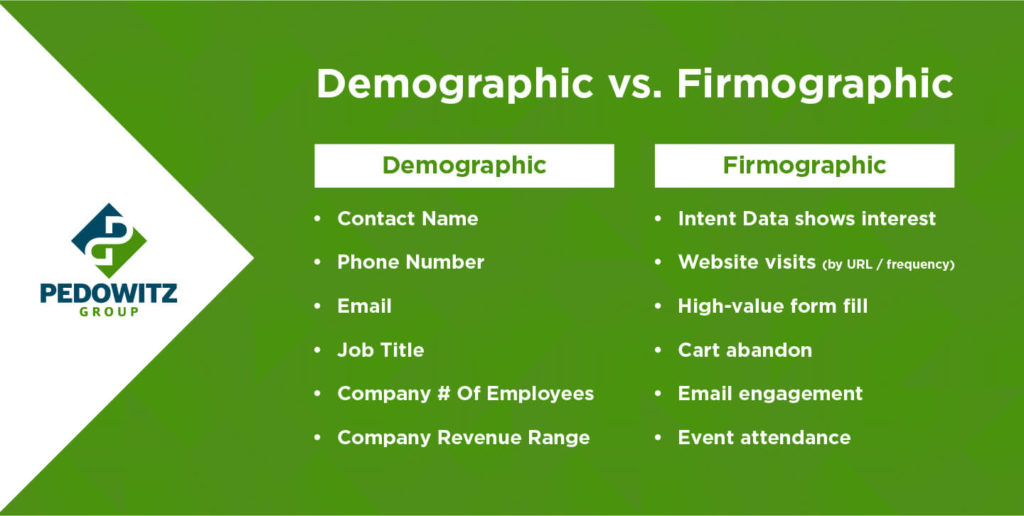
Creating the sales-ready lead definition
So how does a company create this unified definition? Sales and Marketing must come together in the same room and discuss it.
- Marketing can facilitate the discussion on the value of common lead definitions and provide proof points, value statements, and examples of digital body language and demographics.
- In return, Sales can provide Marketing with information about what they are trying to sell and how they are trying to sell it.
Working together, Sales and Marketing develop and validate a sales-ready lead’s definition (or definitions), leading to greater SQLs as sales focus their efforts on the highest-quality leads.
These definitions should be reviewed quarterly and updated with critical stakeholders as needed, then baked into the technology CRM, ensuring all stakeholders use them consistently.
Barriers and Accelerators
There are several barriers to accomplishing these goals. Getting Sales and Marketing to work together in the same room can be difficult, not to mention getting Sales and Marketing to agree on behavioral data that matters.
Whether or not Marketing can capture the behavioral/demographic data that Sales wants is also tricky.
In addition, implementing the new sales-ready lead definition will be challenging. There will be differences of opinion between different marketing stakeholders, and some stakeholders won’t hold people accountable for doing something with a qualified lead. Both teams need to be educated on the new definition of a lead and what they do with it.
Here are some accelerators to overcome these barriers:
- A desire and a strong business case for change (to see Marketing contribute to the Sales pipeline).
- Executive support from Marketing to focus on the quality of sales-ready leads over quantity.
- Executive support from Sales to act on qualified leads passed over from Marketing.
As long as there’s an agreement between Sales and Marketing on the new definition of a sales-ready lead, and as long as executives hold people accountable for new behaviors, you will achieve success and drive more SQLs.
Stage 2: Seek agreement on labels and definitions of customer acquisition/retention statuses
In your CRM, you’ll rely on statuses to determine success. Having an agreed-upon set of definitions enables seamless lead funnel management, captures the lead lifecycle in a common language everyone understands and allows you to predict revenue based on the pipeline.
A lead becomes “sales-ready” through a series of stages – a funnel that should be common between Sales and Marketing:
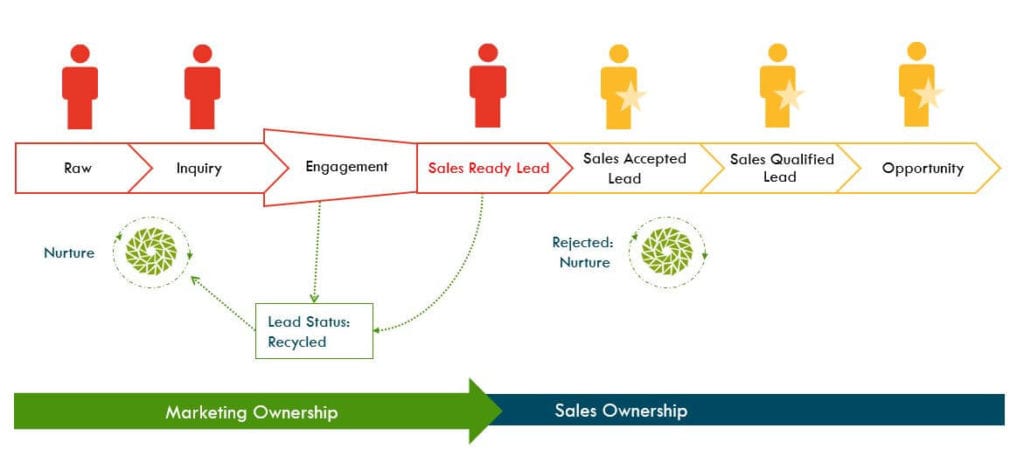
You’ve already defined your sales-qualified lead, but there are other stages. Marketing and Sales must find common ground here to work together efficiently.
Sample lead stage definitions include:
- Raw: You have an IP address but cannot connect it to an actual person.
- Inquiry: You have captured an email through engagement (they have made themselves known).
- Engagement: The lead is doing something.
- Sales Ready Lead (a.k.a. Marketing Qualified Lead): The lead has shown enough interest (activity) to be marketing qualified or has filled out a “Contact Us” form and meets your established demographic minimum.
- Sales Accepted Lead: Sales has accepted the lead from Marketing and agrees to review it within an established amount of time (for example, 24 hours).
- Sales Qualified Lead: A lead is recognized by sales as having a viable need and is qualified by Sales. Sales can also reject and recycle leads.
- Opportunity: This is an opportunity with a revenue value. Link the opportunity to the primary contact.
- Rejected: This lead is non-targeted. It will never be a customer. The Rejected Reason field must be filled out.
- Recycled: The lead does not meet sales criteria and is sent back to marketing for re-work.
There is a difference between A stage and A status.
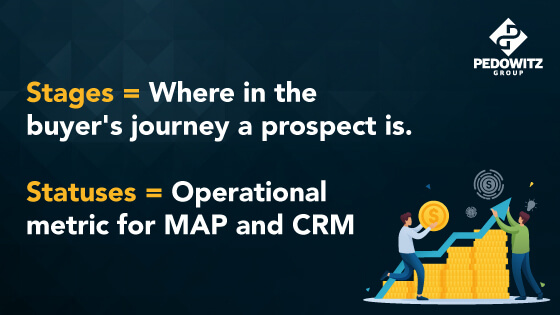
- Stages represent an executive level view of the common funnel and broadly represent where and how a customer is engaging with your company. Think top, middle and lower part of the funnel (or early, middle and late stage of a given loop buying cycle).
- Statuses are the detailed operational views of where and how a customer is interacting with your company. These are represented in the technology (both marketing automation and CRM).
It is the lead statuses that bring the marketing automation platform and the CRM together. Otherwise, the systems are fighting each other.
Now that systems are aligned, Marketing and Sales have visibility on the follow-up actions needed on leads (rejecting, recycling, and so on).
A specific value is now assigned to a sales-qualified lead.
This value is built into your marketing automation platform, which triggers the status change and kicks the qualified lead over to Sales.
This system provides a wealth of value to Sales and Marketing and the Executive team. Not only is there more transparency between all teams, but there is also a common language between the teams and predictability of lead flow. Sales and Marketing can work more efficiently and effectively, and productivity increases while budget management gets easier.
It might still be challenging to sell the value of a funnel with lead stages and statuses that are common between Sales and Marketing. Here is a suggested plan of action:
- Understand the current sales funnel definitions and use.
- Review existing marketing stages, CRM statuses, and the state of one common funnel.
- Determine the gap between the two.
- Meet with key stakeholders to share what was learned and take feedback.
- Create one common funnel.
- Gain agreement with key stakeholders.
- Implement with/in process and technology.
Related: Our lead management consulting brings all teams together to make this happen
Stage 3: Optimize prospect process flow using automation
Using automation to optimize your prospect process creates a defined flow for what happens to a lead upon acquisition. This ensures that no lead is left behind and the prospect/customer has a positive experience.
It used to be that marketing automation was enough. And it’s still highly relevant – but not on its own.
Advances in technology have led to the ability to have a stronger customer experience – and more robust database. These tech options help you fill the gaps of the necessary fields needed to build a “complete” picture of a given lead – or even an entire company, giving you a more robust lead process flow.
These technologies include:
- Data enrichment – ZoomInfo, InsideView, Clearbit
- Sales orchestration – SalesLoft, Outreach, Chorus.ai
- Data intent / ABX platforms – 6Sense, Demandbase, Terminus
- Conversational marketing – Drift, Intercom
These are only a few examples of the many technologies that have added complexity to the back end of lead processing.
Are they necessary?
Maybe.
It depends on what you are trying to accomplish!
Related: Tech stack audit questions you should be asking today
But don’t forget the “basics”
Marketing automation, when done well, helps you engage prospects and customers:
- New, hot leads are presented with relevant cross-channel content via email, mobile, web, and social channels
- Warm leads are encouraged to re-engage with your company and ideally turn into a hot lead
- Cold or un-engaged leads can be sent content they may find interesting, which could bring them towards the warm stage
The problem is we continue to see – yes, even today, while you’re reading – marketing automation platforms with a ton of bad data, processes, and campaigns that undermine marketing efforts.
Your CRM helps you identify current customers, lead or accounts owners and assigns ownership to the appropriate salesperson. It also holds opportunity data that can be used to identify where the contact is within your operational funnel.
Note a contact could be for net-new or existing accounts. How these are treated in your system will differ, especially as you consider how to market to net-new vs. existing customers.
Related: Our marketing technology services take out any guesswork (and non-optimal integrations)

Stage 4: Confirm/document lead routing
Confirming and documenting lead routing ensures any given lead is automatically sent to the appropriate person when the prospect meets particular qualification criteria.
Lead processing begins with the source of the lead. When considering lead processing, you must consider your best lead sources. Lead sources include social (for example, LinkedIn, Twitter, and Facebook), webcasts, tradeshows, sales sourced, and so on.
Lead processing is the flow by which a lead enters your system and becomes known to your marketing automation process, following through MAP and CRM until it is closed/won. This process needs to be documented and includes all the technology systems contributing data to the contact/account. Ideally, all of these technologies are integrated to make the processing faster.
Lead processing matters because it clearly defines what will happen when a qualified lead arrives in your MAP. It helps marketing understand which lead sources are better than others in sourcing leads. It also ensures a fluid process when leads are passed over to sales and back to marketing.
Routing vs. Processing
Lead processing is the flow by which a lead enters your system and flows through your technology. This process needs to be documented and include all the technology systems contributing data to the contact/account.
Ideally, all of these technologies are integrated to make the processing faster. Simply put: Many still aren’t.
Lead routing is the automated process by which we assign system-qualified leads to the right salesperson (by geography, product sales, and so on). Automating lead routing ensures that the prospect is followed up promptly by the right person.
The value of lead processing and routing for Sales is they receive high-quality leads promptly, giving them higher conversion rates and improving first-call quality. For Marketing, the value is found in the automation, timeliness, efficiency, and effectiveness of lead processing and routing.
They’ll be able to nurture leads that sales will want to follow up on with relevant content and experiences, which should lead to higher conversion rates from SRL to Opportunity.
Marketing’s productivity will increase, as will their ability to transparently track their output.
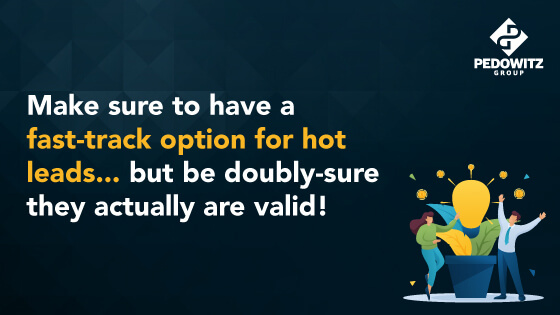
The routing itself
Many companies have a round-robin approach with leads, while others leverage campaign parameters to designate a given lead to the right salesperson.
If necessary, you can put “stopgaps” in place in the distribution of leads to slow down the routing process (for example, a manager receives all of the leads and then distributes them). However, not having a fast-track option prevents truly hot leads from getting straight to Sales.
World-class characteristics
Lead processing begins with the source of the lead. Consider this: what are your best lead sources? They could come from your social platforms (LinkedIn, Twitter, Facebook), webcasts, organic or paid searches, your website, customer referrals, tradeshows, campaigns, or third-party placements.
Wherever they come from, they should be given a specific naming convention. For example, a lead source from a tradeshow could be named “2022_TradeShowName_LeadManagementProduct.”
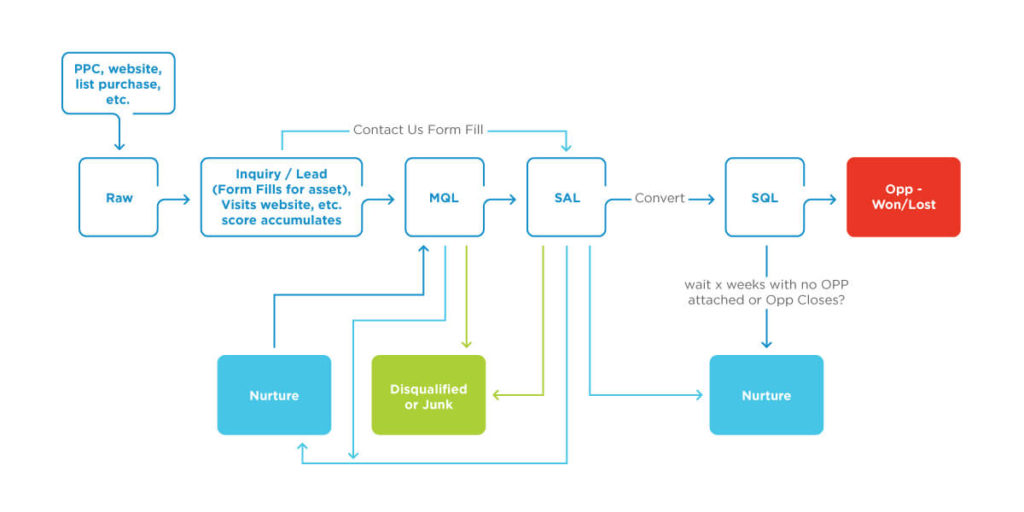
Note the moments when a lead is looped back into Marketing for nurturing. This entire process and all of the technologies involved should be documented so everyone (Sales and Marketing) understands the lifecycle of a lead.
Here is a roadmap to developing your lead processing and routing management process:
- Map your current lead flow by lead source and look for inefficiencies in the following five areas (remember to collaborate with Sales!):
- Use of technology
- The actual route of the lead
- Who does what with the lead along each stage of the route?
- How long the lead stays in each stage
- Data/intelligence being passed with the leads
- Once you have gathered this information, begin to modify your current lead processing to eliminate inefficiencies. Again, remember to collaborate with Sales!
- Work with sales to understand and determine the rules for routing the lead to the appropriate salesperson.
- Ensure the technology supports optimal lead processing and optimal lead routing.
- Ensure the SLA supports the goals and required actions for lead processing and routing actions.
Throughout the planning and development phase, and especially as you enact your revamped lead processing and routing plan, it is vital to maintain open communication between Marketing and Sales.
If Marketing and Sales are both clearly educated on the new process, buy-in will be easy, and adoption will be quick.
Stage 5: Optimize prospect/customer scoring for automation
While often the focus of everyone interested in lead management, lead scoring is only part of the process. It can also auto-qualify leads based on digital behavior and demographic information.
As a reminder: Lead scoring is a methodology used to rank prospects against a scale representing the perceived value each lead represents to the organization. The resulting score determines which leads a sales or inside sales associate will engage in order of priority.
You determine what counts – for instance, downloading a white paper or watching a particular webinar would increase a person’s lead score.
This focuses sales attention on leads the organization deems most valuable, ensuring that unqualified leads or leads with low value are not sent to sales, which means they’ll know any lead you send them is worth their time!
This is a vital process … so much so that if this is done poorly, it undermines everything else. But lead scoring is also only one part of a winning lead management process.
Lead Scoring Determines What’s Ready For Sales Attention
In stage 1, you defined what “ready for sales” actually means. Here, you build the process that automates it.
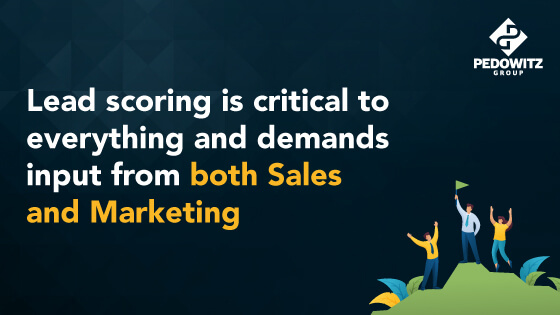
Remember, a qualified lead is defined using a combination of digital behavior and demographic information. We assign a numerical value to specific actions (visits to the website, downloads of an asset, etc.) that a customer or prospect takes throughout their engagement with you, coupled with key demographic information. Lead scoring is built to qualify leads based on these criteria.
When the sum of their scores meets a pre-determined threshold, the lead is considered sales-ready (or marketing-qualified) and is passed over to Sales for follow-up.
(re)Build Your Lead Scoring Model
Do this with key Sales staff in a 1-2 hour working session. Keep the lead scoring model simple at first. As you begin to pass leads to sales, collect feedback from Sales on the quality of the leads.
You will want to adjust scoring if too many unqualified leads get through (suggesting that your algorithm is too loose) or if not enough leads are getting through (implying that your algorithm is too rigid).
As you build out your scoring model with your Sales partners, be sure to cover the following questions:
- Which demographic variables are most important to your Sales team?
- What demographic attributes are most common in closed-won deals?
- Which behaviors represent buying interest?
- Which behaviors should be weighted highest?
- Do any behaviors indicate negative buying interest?
- Can you classify your behaviors into buying stages (early, mid or late-stage buying activity)?
Here’s three additional items to consider:
Identify the behaviors that make a good lead.
What behaviors indicate purchasing intent? (Spoiler: just because someone has opened your email does not mean they want to buy anything!)
Web activity, email engagement, webinar attendance, and tradeshow engagement; are all examples of activities that, when looked at holistically, may paint a picture of someone who is ready to buy. Work with your sales team to identify the most relevant activities and give those the highest score value.
If you’re scoring web visits, analyze how you apply those scores.
Not all webpages are created equal!
A pricing page represents stronger buying intent for a visitor than a homepage visit. Identify some key pages that are worth more and identify any pages that you may want to exclude from scoring (a careers page, for example).
Don’t be afraid to iterate.
Once you get your scoring set up, monitor it closely. Is it performing how you expected? Are the leads you call ‘Qualified’ going on to close deals? Are sales satisfied with the quantity and quality of leads you are sharing? It may take some tweaks to get to a point where you are pleased with your model.
You’ll notice that an underlying assumption for each of these tips is that you are communicating with your sales team. Sales and marketing alignment is a critical element when establishing your scoring model!
It’s also essential to use one lead-scoring model across the entire organization. You can customize the model for a business unit or product as needed, but there should only be one lead-scoring model that everyone can refer to.
Once you have created your model, it’s time to test and verify your new lead-scoring design. We often suggest that our clients run a small pilot of sample leads through scenario tests with a newly designed lead scoring program.
- Example 1: Existing closed/won customers
- Example 2: Existing closed/lost opportunities/contacts
- Example 3: Leads that were unqualified by Sales
Ask yourself this key question – Would these leads have been assessed correctly by our new scoring model?
If the answer is yes, it’s time to move forward with the next steps. Build out new lead scoring campaigns and if you have an algorithm in place, retire old scoring campaigns. Reset your lead scores (demographic and behavioral), re-score demographic information, and then monitor your new scoring programs for the next four weeks.
Four weeks after launching your new model, reassess.
Ask Sales for feedback. Verify your design through a pilot test. (Are qualified leads meeting the MQL threshold? Are the right leads qualifying for scores? Are they where they are supposed to be in the funnel?) Finally, update your scoring model.
Scoring is an iterative process. Your model should be reviewed, at a minimum, every quarter. As your lead quality and volume stabilize, you can push that back to every six months.
To reiterate, while lead scoring is not the entirety of the lead management process, it is an integral part. Good lead scoring increases Sales’ efficiency and effectiveness, Marketing’s effectiveness and helps bring Marketing and Sales into tighter alignment. World-class lead scoring is:
- Reflective of the definition of a sales-ready lead.
- Created by Marketing and Sales.
- Inclusive of digital body language (behavioral data).
- Limited to one lead scoring model with customization for a business unit, ABM or product as needed.
- An iterative process.

Stage 6: Establish and document a comprehensive Service-Level Agreement
A Service-Level Agreement (SLA) is a document that captures the roles and responsibilities of sales and marketing throughout the lead management process. It’s implemented to achieve better understanding and alignment between the teams.
Both sales and marketing must commit to following the SLA to make the lead management process work. It will need to be put into place, monitored, and revised based on results.
Ultimately, the SLA is intended to assign joint accountability to sales and marketing for generated leads and prevent lead funnel decay.
Components
Documenting roles and responsibilities is the easy part. It basically says, as a Marketer, I’ll do this to help generate high-quality leads for the business. As a Salesperson, I agree to do this to manage the high-quality leads we receive and work them to close.
In many cases, it’s a simple table:
| Sales | Marketing |
| View campaign engagement per contact in SFDC | Craft go-to-market campaigns |
| Accept/reject marketing qualified leads | Generate net new leads and expansion within customer accounts |
| Convert leads to contacts/opportunity | Create new content |
| Maintain account/contact info | Score leads and qualify them |
| Add primary contact info to opportunity | Nurture leads |
| Manage MQL queues | Hand off leads to Sales |
| Read communications from Marketing | Communicate marketing efforts to Sales |
| Promote upsell and cross-sell of products | Report on marketing operations |
World-class SLAs map out the lead management process so everyone involved knows exactly what they should do.
The other critical element: Time
How much time Sales has to accept a qualified lead once it has been kicked over from Marketing is a must-have for any SLA.
Usually, give 24-48 hours for a salesperson to accept a lead. This is just Sales saying, “Yes, I see this lead, and I agree to work it.” They would then need to change the disposition of the lead status in CRM to “Accepted Lead” or whatever language you use to indicate this has happened (we have used “Sales-Accepted Lead (SAL)” before).
If the SLA says they have 48 hours to disposition a new lead, and nothing happens in CRM to indicate that Sales have noticed the lead, we will send an auto alert to the salesperson – a reminder. If nothing happens within another 24 hours, we send another auto alert, with an escalation copying their boss. If nothing happens in another 24 hours, we reassign the lead.
That is a typical example of a lead processing agreement that must be included in the SLA. It ensures that Sales are actually working the leads that Marketing is generating. And we know that the leads are qualified based on the fact that we developed the definition of a qualified lead together and that we built the scoring algorithm to support that definition.
To help you visualize what that SLA looks like across the funnel, we’ve provided a high-level sample below:
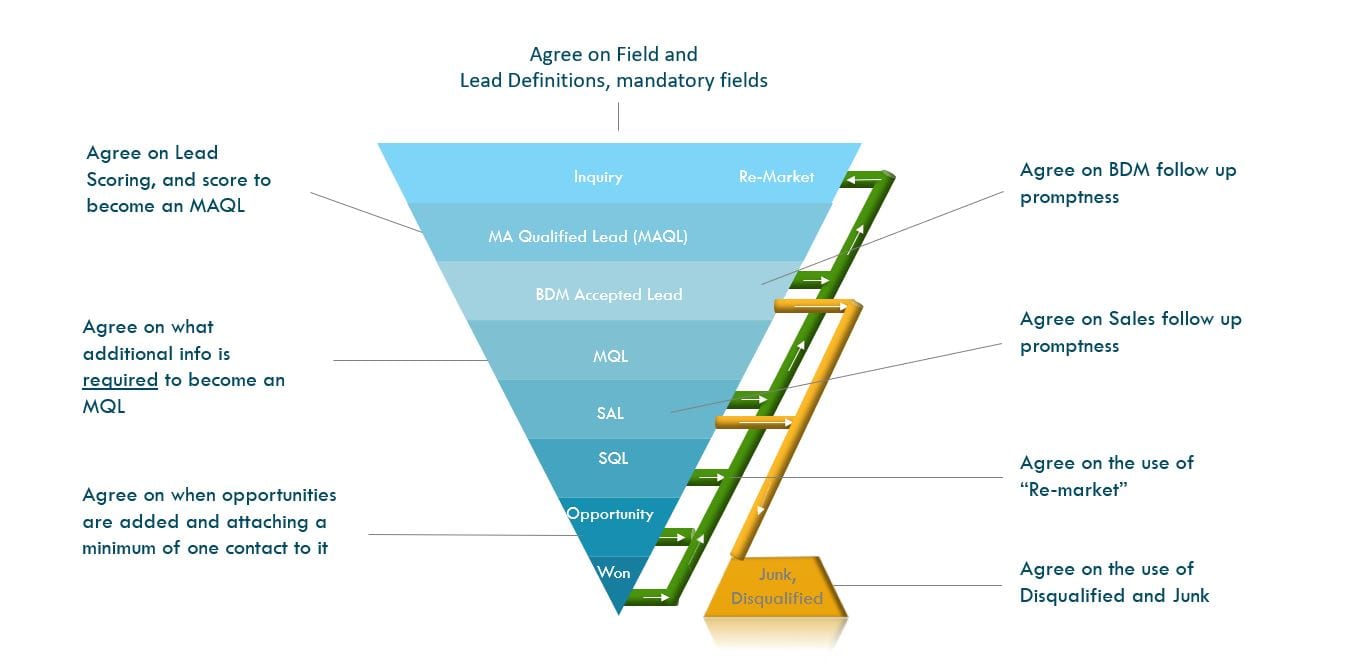
As you can see, the SLA is involved at every stage of the life of the lead. The SLA provides enormous value to Sales and Marketing as it aligns them. The SLA clarifies roles and expectations, providing a standard process and language that allows the Marketing and Sales machines to work together as a joined unit.
Tips to implementing an SLA in your environment
In order to sell the benefits of SLAs, create a presentation with the value to present to your company.
- Meet with key stakeholders to show them proof points.
- Ask for feedback, and create continuous visibility through meetings and dashboards.
- Finally, create, communicate and sign the Service Level Agreement. Remember to review and revise the SLA quarterly.
There are, of course, potential barriers for implementing this.
Sales might not agree to any implementation, or Sales might not agree to the terms of marketing’s ideal SLA. It’s important to get Sales leadership on board with your plan to create and implement an SLA before moving forward.
Key takeaway: Include sales in the SLA design process!
Another potential barrier is accountability on both sides to the terms of the Service Level Agreement. Again, it is crucial for sales and marketing leadership to be on board with the SLA plan and to be educated on the terms of the agreement so that they can hold their staff members accountable.
Key takeaway: SLA adherence can be measured in the systems. Check adherence often, and be sure the sales team knows that you can zero in on the specific sales people who are not following process. Transparency is a motivator!
Stage 7: Establish the Foundation for Customer Management Analytics – from Acquisition to Advocacy
If we broaden the definition of lead management to define a Customer Journey Map process (for example, the Loop), then lead management becomes defined as a process methodology.
In other words, a company attracts, acquires, and nurtures prospects until qualified to be passed to sales, and where sales is held accountable for processing those prospects through to close.
This is where a lead management model such as below comes in handy. Welcome to The Loop:
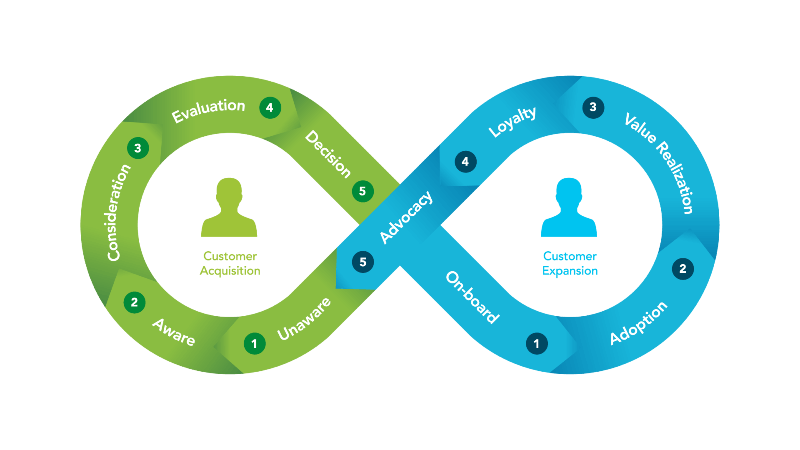
Marketing now interacts with customers during their many stages of product adoption and value recognition, encourages loyalty and advocacy, and ultimately nurtures them back into a new buying cycle and re-qualifies them for sales engagement.
The components of the process remain the same, but additional stages beyond the first deal close are included.
Characteristics of Lead Management (Customer Acquisition)
Let’s put lead management in perspective. Lead management supports new business generation. It also brings your customers, people, process, and technology together to produce a sales-ready lead that converts at the highest possible rate into an opportunity and a closed deal.
From a people perspective, effective lead management is characterized by a tight working relationship between Marketing and Sales. From envisioning what will resonate with prospects to effective lead processing, Sales and Marketing play pivotal roles.
The model’s left side speaks to the process by which we acquire new individuals and manage their journey through our engagement process. If we do this correctly, with the right messages, we will create a fluid experience for the prospect and optimize outcomes for the company.
Characteristics of Customer Management (Customer Expansion)
Now let’s look at customer management or expanding the current business relationship. The model’s right side represents Customer management, which is also a process specific to upselling and cross-selling current customers.
Customer management is still the practice of synergizing people, processes, and technology, but in this case, to optimize the customer experience with your company so that they will be inclined to give you more business.
In addition to Sales and Marketing, other key stakeholders include customer service, operations, IT – any functional area interacting with the customer as they onboard, adopt, and realize value. Careful planning, orchestration, and functional alignment are necessary to create a singular view of the customer and improve the quality of the customer experience.
From the customer’s perspective, customer management creates the feeling that your business is easy to work with, buy from, and interested in helping them solve their business problems. As a partner to your customers, your goal is to help them optimize outcomes no matter who they’re working with.
Engaging With Our Customers/Prospects
So, how do we engage with our customers at every stage of their journey?
A prospect becomes qualified through a series of buying stages. Use these stages to map out your customer journey stages and definitions in your lead management process and identify critical points that make the most sense to nurture.
- Should someone reach out on LinkedIn?
- Is an email with a relevant piece of content worthwhile?
- Do you have an assessment they can take to learn more?
These are just some examples!
Shift to viewing the funnel from the buyer’s perspective … with a few key considerations.
The Loop more accurately reflects the entire product/service related engagement between a customer or prospect and their vendor/supplier/provider.
- The model aligns all functions of the organization around optimizing the customer experience.
- It more closely aligns marketing with sales and support and their relationships with customers.
- It also incorporates customer status fields to reflect when a prospect has become a customer. This puts more structure around program planning and campaign planning for specific solutions and cross-sell/upsell opportunities.
Who in your marketing operations team owns the journey and is responsible for updating it?
Knowing your maturity level gives you the knowledge to improve and adjust your marketing strategy.
As you reflect on where your organization is, here’s a summary of the stages:
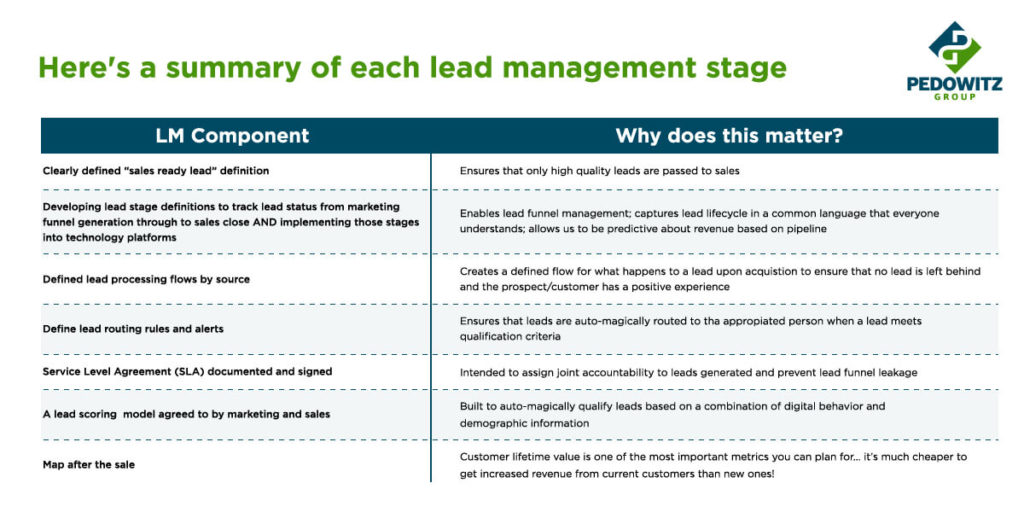
Ready to improve your lead management?
It’s not easy, but it absolutely can be done! Get started with one of these options:
- Get even deeper by building a strong marketing center of excellence
- Read more into our methodology for lead management, The Loop
- Fortify your process with our lead management consulting!

